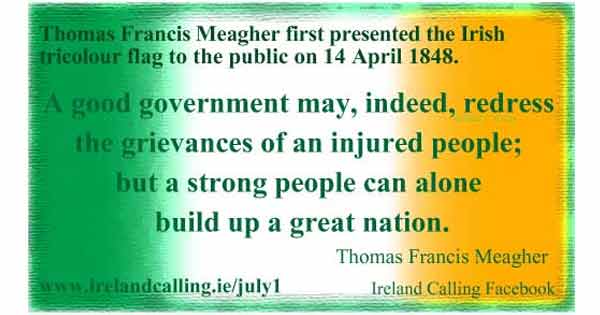The Irish national flag is recognisable around the world, and is a symbol of pride for athletes, sportspeople, emigrants and Irish residents today.
The green, white and orange tricolour was not always the national flag of Ireland. The flag was given to Irish rebels in the mid-19th century by a group of French women who sympathised with their cause. The design is of course similar to that of the French tricolour of red, white and blue.

For Ireland, the tricolour is made up of green to represent the ancient Gaels, orange to represent the northern followers of William of Orange, and white to symbolise a peace between them.
For centuries Ireland was a part of the British Empire, and so the national flag flown in Ireland was the Union Jack.
Irish independence needed its own flag
However, in the late 16th century some people in Ireland began to fight for independence from Britain. The failed rebellions of 1798 and 1848 were fought by the United Irishmen. They fought under the old Confederate Ireland flag, which was a yellow harp on a green background.
These rebellions were unsuccessful but the feelings of Irish nationalism spread throughout the next hundred years, particularly because of the harsh treatment by the British authorities during the years of the Great Famine.
By 1848, a new group of Irish nationalists had been formed, called the Young Irelanders. One of the leaders of this group was named Thomas Meagher, the son of the Mayor of Waterford.
Irish Tricolour was a gift to Ireland from the French
Meagher had travelled to France to study the revolutionary events that had taken place just fifty years earlier. There was a hope amongst the Young Irelanders that a similar rebellion was not far away in Ireland.
While in France, a group of French women presented Meagher with the flag that has now become known as the Irish Tricolour.
He returned to Ireland with the flag, and it was flown in public during the Waterford by-elections. The Young Irelanders took part in a rebellion but it was quickly quashed by the British authorities. Most of the leaders were sent to labour camps in Australia. The flag was rarely seen again until the Easter Rising of 1916.
This was partly because the Tricolour had not been standardised in design. Sometimes it was flown with the green stripe next to the staff, and sometimes the orange. There was also a period when the orange stripe was replaced with a yellow one, mainly during Charles Parnell’s political movements towards Home Rule. Another variation included an image of the Red Hand of Ulster in the middle of the white stripe.
Because of these inconsistencies with the Tricolour, the older Confederate Ireland flag was still seen by most as the symbol for Irish nationalism between 1848 and 1916.
Tricolour was used at the Easter Rising
When the Irish Volunteers tried to seize control of Dublin at the Easter Rising, they flew the Irish Tricolour above the General Post Office.
From that moment forward, it was adopted by Irish nationalists as their flag.
When the Irish Free State was formed in 1922, it continued to use the Irish Tricolour as the national flag, whilst Northern Ireland, now partitioned and a separate country, remained loyal to the British crown and saw the Union Jack as its flag. It also created the Ulster Banner, the national flag of Northern Ireland.
In 1937, when Ireland became an independent republic, it officially made the Irish Tricolour as the national flag.
history.html
